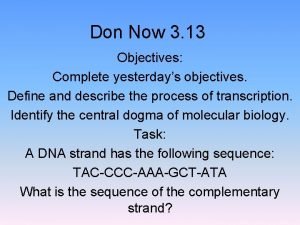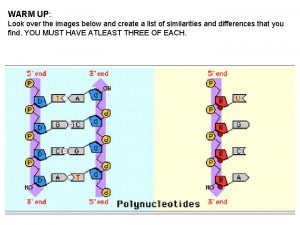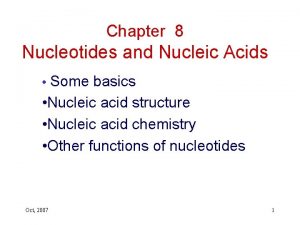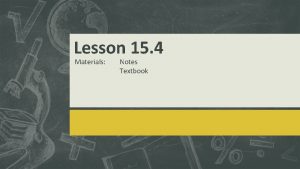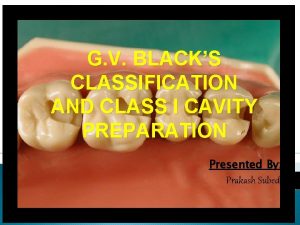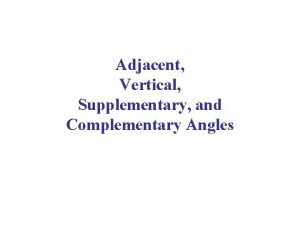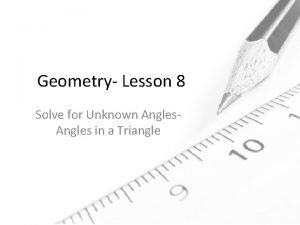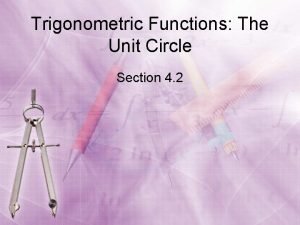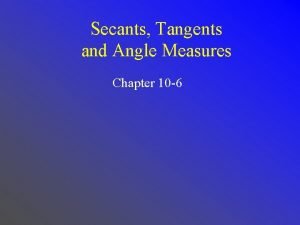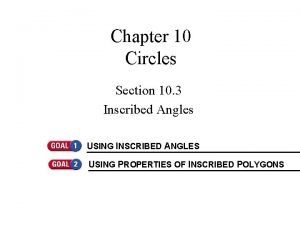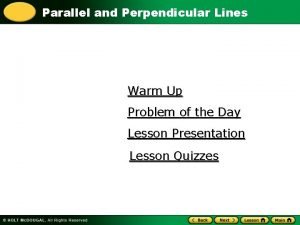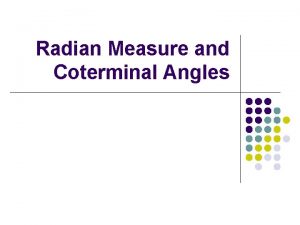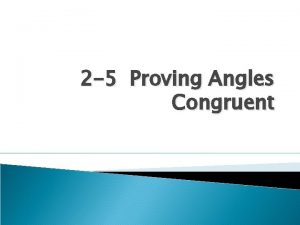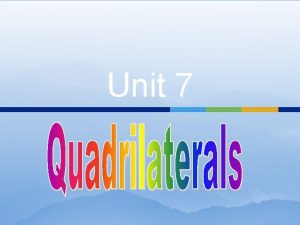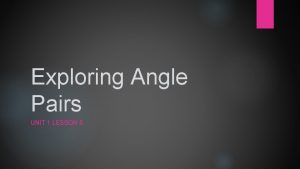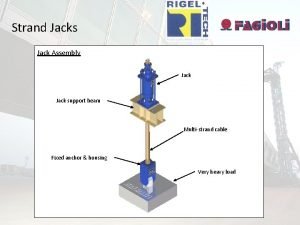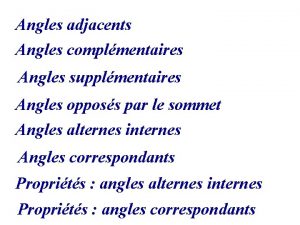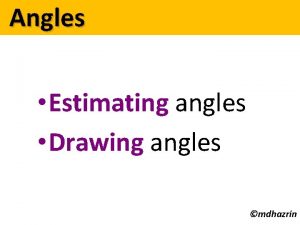TSST Strand H UNIT H 1 Angles and





































- Slides: 37

TSST Strand H UNIT H 1: Angles and Symmetry

Strand H Unit H 1 Angles and Symmetry This Unit introduces angles, their measurement and relationships between angles on straight lines and in shapes. You have five sections to work through and there are check up audits and fitness tests for each section. 1. Measuring Angles 2. Line and Rotational Symmetry 3. Angle Geometry 4. Angles with Parallel and Intersecting Lines 5. Angle Symmetry in Regular Polygons

Strand H Unit H 1 Section H 1. 1 Measuring Angles An angle is a measure of turn. Angles can be measured in degrees: 180 degrees is a half turn, 360 degrees a full turn and 90 degrees a quarter turn, known as a right angle. A protractor can be used to measure or draw angles.

Strand H Unit H 1 Section H 1. 1 Measuring Angles: Examples Example 1 Measure the angle CAB in the triangle shown. Solution

Strand H Unit H 1 Section H 1. 1 Measuring Angles: Examples Example 2 Measure the marked angle. Solution

Strand H Unit H 1 Section H 1. 1 Measuring Angles: Examples Example 3 Solution Then remove the protractor and draw the angle.

Strand H Unit H 1 Section H 1. 1: Fitness Check Here are some questions to check your progress; there are more practice questions if needed. 1. Estimate the size of each angle, then measure it with a protractor. Answers 2. a) b) c)

STRAND H Unit H 1 Section H 1. 1: Review You have completed the first Section. If you have completed and understood this section, click to start the next Section. If you need more examples and interactive practice, go to http: //szalonta. hu/ske/text/H 1/skeh 1 s 1. html

STRAND H Unit H 1 Section H 1. 2 Rotational Symmetry An object has rotational symmetry if it can be rotated about a point so that it fits on top of itself without completing a full turn. The shapes below have rotational symmetry. In a complete turn this shape fits on top of itself two times. In a complete turn this shape fits on top of itself four times. It has rotational symmetry of order 2. It has rotational symmetry of order 4.

STRAND H Unit H 1 Section H 1. 2 Line Symmetry and Reflection Shapes have line symmetry if a mirror could be placed so that one side is an exact reflection of the other. These imaginary 'mirror lines' are shown by dotted lines in the diagrams below. This shape has 2 lines of symmetry. This shape has 4 lines of symmetry.

STRAND H Unit H 1 Section H 1. 2 Line and Rotational Symmetry: Example 1 For the given shape, state: a) the number of lines of symmetry, b) the order of rotational symmetry. Solution a) There are 3 lines of symmetry, as shown. b) There is rotational symmetry with order 3 because the point marked A could be rotated to A' then to A'' and fit exactly over its original shape at each of these points.

STRAND H Unit H 1 Section H 1. 2: Fitness Check Here are some questions to check your progress; there are more practice questions if needed. Which of the shapes below have a) line symmetry b) rotational symmetry? For line symmetry, copy the shape and draw in the mirror lines. For rotational symmetry state the order. A B C Answers a) A - 4 lines, b) A - order 4, B - no lines, B - order 3, G - 2 lines G - order 2

STRAND H Unit H 1 Section H 1. 2: Review You have completed the second Section. If you have completed and understood this section, click to start the next Section. If you need more examples and interactive practice, go to http: //szalonta. hu/ske/text/H 1/skeh 1 s 2. html

STRAND H Unit H 1 Section H 1. 3 Angle Geometry There a number of important results concerning angles in different shapes, at a point and on a line. In this section the results from the following two slides will be used.

STRAND H Unit H 1 Angle Geometry Section H 1. 3 Note that the tick marks mean lines of equal length Angles in an Isosceles Triangle In an isosceles triangle two sides are the same length and two angles are the same size.

STRAND H Unit H 1 Section H 1. 3 Angle Geometry: Examples Example 1 Find the sizes of angles �� and �� in the diagram on the right. Solution

STRAND H Unit H 1 Section H 1. 3 Angle Geometry: Examples Example 2 Solution continued on next slide

STRAND H Unit H 1 Section H 1. 3 Angle Geometry: Examples Solution (continued)

STRAND H Unit H 1 Section H 1. 3 Angle Geometry: Examples Example 3 Solution

STRAND H Unit H 1 Section H 1. 3: Fitness Check Here are some questions to check your progress; there are more practice questions if needed. 1. Find the size of the angles marked with a letter in each diagram. i) iii) Answers iv)

STRAND H Unit H 1 Section H 1. 3: Fitness Check Here are some questions to check your progress; there are more practice questions if needed. 2. Find the size of the angles marked with a letter in each diagram. i) iii) iv) Answers

STRAND H Unit H 1 Section H 1. 3: Review You have completed the third Section. If you have completed and understood this section, click to start the next Section. If you need more examples and interactive practice, go to http: //szalonta. hu/ske/text/H 1/skeh 1 s 3. html

STRAND H Unit H 1 Section H 1. 4 Angles with Parallel and Intersecting Lines Opposite Angles When any two lines intersect, two pairs of equal angles are formed.

STRAND H Unit H 1 Section H 1. 4 Angles with Parallel and Intersecting Lines: Examples Example 1 Solution There are two pairs of opposite angles here so:

STRAND H Unit H 1 Section H 1. 4 Angles with Parallel and Intersecting Lines: Examples Example 2 Solution

STRAND H Unit H 1 Section H 1. 4 Angles with Parallel and Intersecting Lines: Examples Example 3 Solution

STRAND H Unit H 1 Section H 1. 4 Angles with Parallel and Intersecting Lines: Examples Example 4 Solution continued on next slide

STRAND H Unit H 1 Section H 1. 4 Angles with Parallel and Intersecting Lines: Examples Solution (continued)

STRAND H Unit H 1 Section H 1. 4: Fitness Check Here are some questions to check your progress; there are more practice questions if needed. 1. Find the angles marked in each diagram, giving reasons for your answers. i) iii) Solutions

STRAND H Unit H 1 Section H 1. 4: Fitness Check 2. Find the size of the angles marked with a letter in each diagram. Solutions i) ii) Solutions

STRAND H Unit H 1 Section H 1. 4: Review You have completed the fourth Section. If you have completed and understood this section, click to start the next Section. If you need more examples and interactive practice, go to http: //szalonta. hu/ske/text/H 1/skeh 1 s 4. html

STRAND H Unit H 1 Section H 1. 5 Angle Symmetry in Regular Polygons Regular polygons have sides which are all equal in length; all interior angles are equal too. Regular polygons will have both line and rotational symmetry. This symmetry can be used to find the interior angles of a regular polygon. Example 1 Find the interior angle of a regular dodecagon (12 sides). Solution The diagram shows how a regular dodecagon can be split into 12 isosceles triangles. Continued on next slide

STRAND H Unit H 1 Section H 1. 5 Angle Symmetry in Regular Polygons: Examples Example 1 (continued) Next we will find the angle indicated on the diagram on the right. The other angles of each triangle will together add up to Therefore the angle on the diagram is As two adjacent angles are required to form each interior angle of the dodecagon, each interior angle will be As there are 12 interior angles, the sum of these angles will be

STRAND H Unit H 1 Section H 1. 5 Angle Symmetry in Regular Polygons: Examples Example 2 Find the sum of the interior angles of a regular heptagon. Solution However the angles at the point where all the triangles meet should not be included, so the sum of the interior angles is given by

STRAND H Unit H 1 Section H 1. 5 Angle Symmetry in Regular Polygons: Examples Example 3 a) Copy the octagon shown in the diagram and draw in any lines of symmetry. b) Copy the octagon and shade in extra triangles so that it now has rotational symmetry. Solutions a) There is only one b) The original octagon has no rotational symmetry. line of symmetry. After shading the extra After shading all the triangle shown, it has rotational symmetry of order 4. triangles, it has rotational symmetry of order 8.

STRAND H Unit H 1 Section H 1. 5: Fitness Check Here are some questions to check your progress; there are more practice questions if needed. 1. Find the interior angle for a regular: a) pentagon b) hexagon c) octagon d) decagon (10 sides). 2. Find the sum of the interior angles in each polygon shown below. i) ii) Answers 3. a) Square b) Hexagon c) Pentagon

STRAND H Unit H 1 Section H 1. 5: Review Section H 1. 5 You have completed the last Section. If you need more examples and interactive practice, go to http: //szalonta. hu/ske/text/H 1/skeh 1 s 5. html
 Dispersive model
Dispersive model Template strand, new strand, base pair, and dna polymerase.
Template strand, new strand, base pair, and dna polymerase. Vertically opposite angles
Vertically opposite angles Mrna strand that is complementary to the dna strand aattgc
Mrna strand that is complementary to the dna strand aattgc Watson strand crick strand
Watson strand crick strand Watson strand crick strand
Watson strand crick strand Module 15 angles and segments in circles answer key
Module 15 angles and segments in circles answer key Undermined enamel
Undermined enamel Complementary supplementary vertical and adjacent angles
Complementary supplementary vertical and adjacent angles Answers
Answers Unit 6 review questions
Unit 6 review questions Topic 2 angles of triangles
Topic 2 angles of triangles Whats primase
Whats primase Course in senior high
Course in senior high Academic track
Academic track Leading and lagging strand
Leading and lagging strand Unit circle negative
Unit circle negative How to solve secants tangents and angle measures
How to solve secants tangents and angle measures Section 10 topic 3 inscribed polygons in a circle
Section 10 topic 3 inscribed polygons in a circle Angles & lines unit warm ups
Angles & lines unit warm ups 3 parallel lines and transversals
3 parallel lines and transversals Coterminal angles unit circle
Coterminal angles unit circle Unit 3 lesson 4 proving angles congruent
Unit 3 lesson 4 proving angles congruent Unit 3 lesson 4 proving angles congruent
Unit 3 lesson 4 proving angles congruent What is regular polygon
What is regular polygon Exploring angle pairs
Exploring angle pairs Name a pair of adjacent supplementary angles
Name a pair of adjacent supplementary angles 1-4 exploring angle pairs
1-4 exploring angle pairs Strand in lesson plan
Strand in lesson plan Victorian curriculum history
Victorian curriculum history Kayuputi at st. regis bali resort nusa dua
Kayuputi at st. regis bali resort nusa dua Audun fauchald strand
Audun fauchald strand Strand plain
Strand plain Multi strand jack
Multi strand jack What strand is baking
What strand is baking Strand in senior high
Strand in senior high Cecilia strand
Cecilia strand Liv strand teori
Liv strand teori

